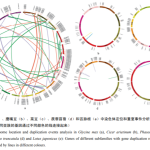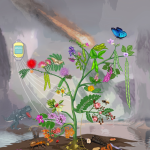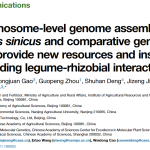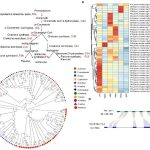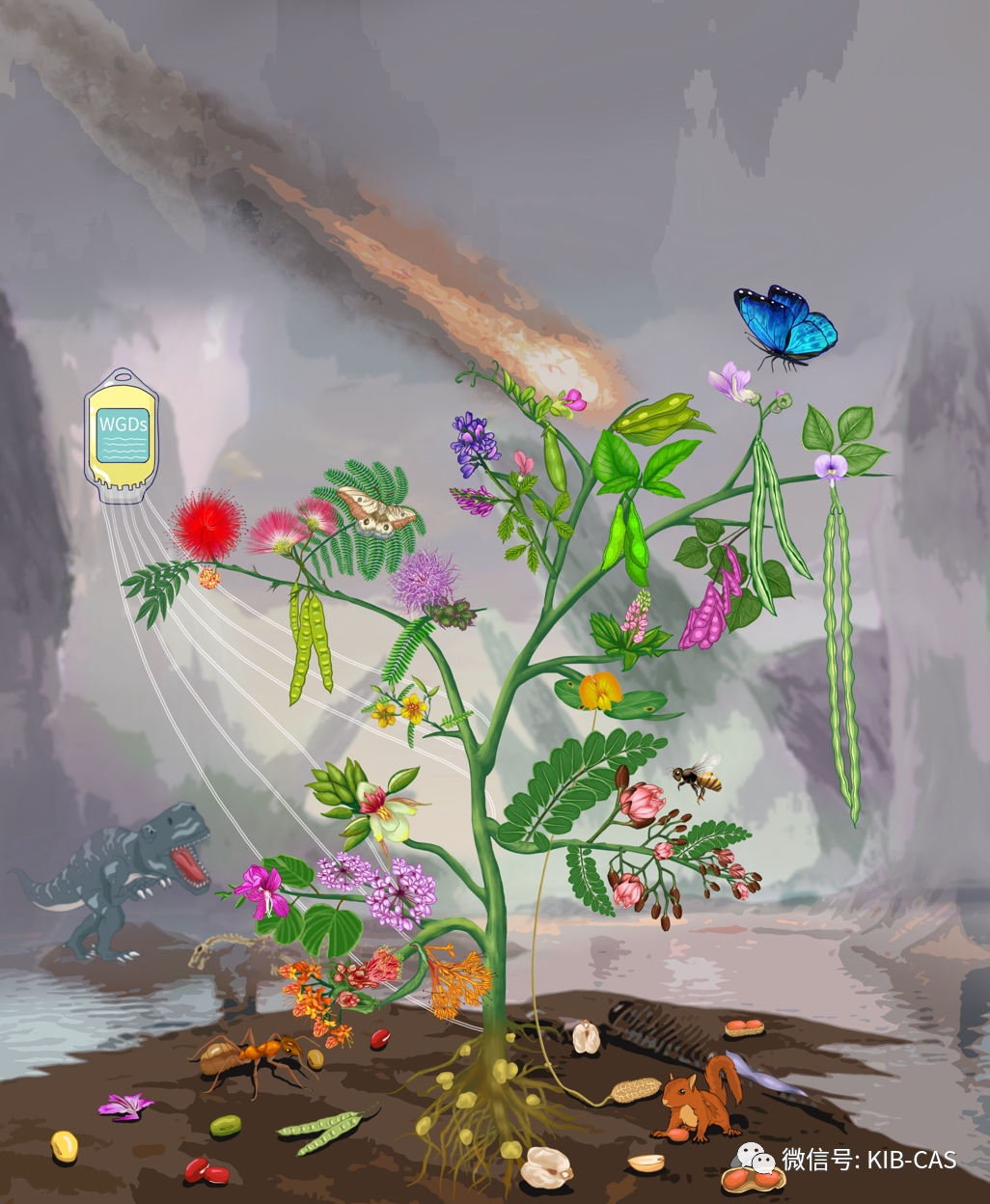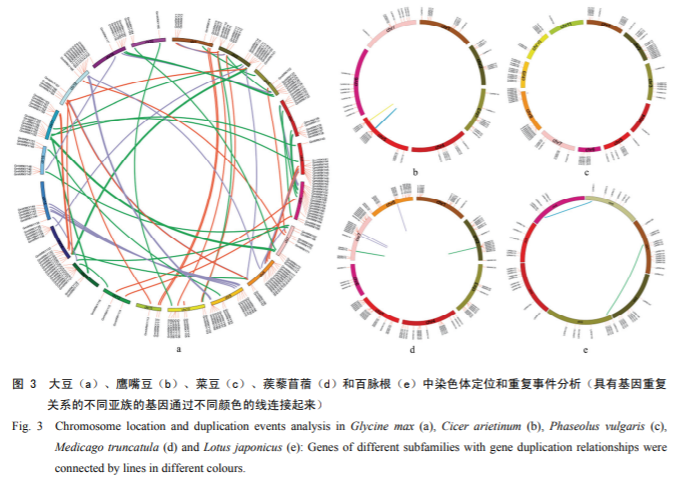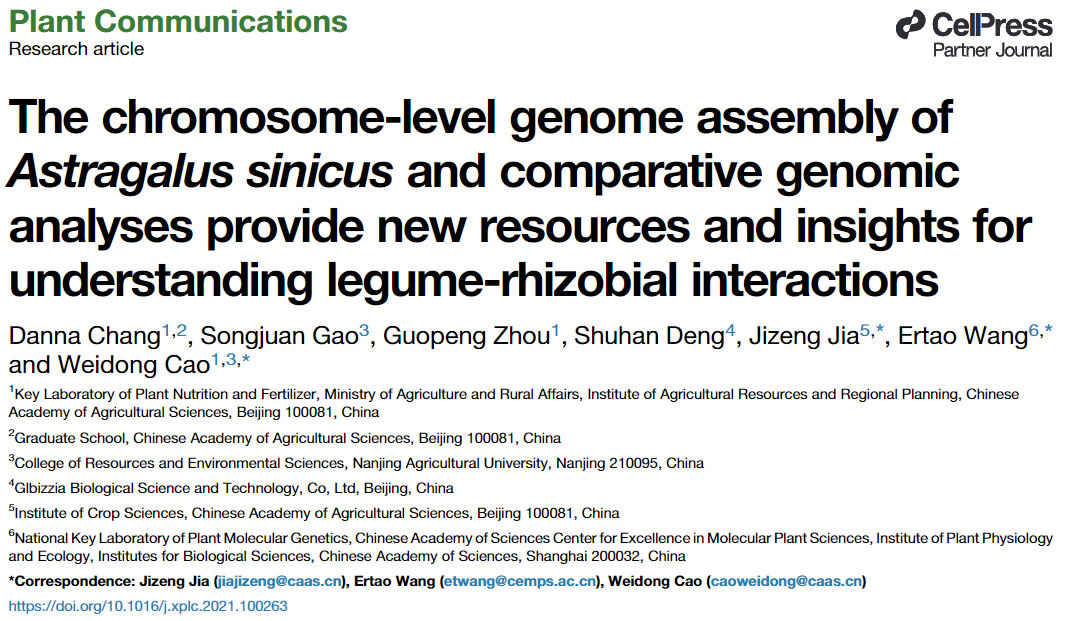The Leguminosae (Fabaceae) are one of the largest families of flowering plants, after Asteraceae and Orchidaceae. It is one of the most successful groups of angiosperms in terms of morphological diversity and adaptability. The Fabaceae family consists of nearly 20,000 species in about 765 genera and contributes 27% of global crop production. It contains a large number of economically important species, many of which are widely cultivated and utilized globally, such as common oilseed crops (soybean, peanut), vegetables or starches (kidney bean, pea, broad bean, cowpea, adzuki bean, black bean, lentil, mung bean, and chickpea), important forage grasses (alfalfa, zoysia), valuable timber (sandalwood, pterocarpus indicus), commonly used Chinese herbal medicines (Astragalus membranaceus, licorice), and fine ornamental plants (zinnia, lambsfoot, mimosa, acacia, phoenix, redbud, and acacia). In addition, the symbiotic nitrogen fixation system of legumes and rhizobia is the most efficient and largest biological nitrogen fixation system in nature, and it is estimated that 17.2 × 107 tons of nitrogen can be fixed annually. Effective utilization of symbiotic nitrogen fixation by legumes and rhizobia is of great significance for sustainable agricultural development. Therefore, exploring the evolutionary history of such an important taxon is not only of great scientific significance, but also of great socioeconomic value.
Recently, a team of 12 researchers from Kunming Institute of Botany, Chinese Academy of Sciences (KIBCS), including researcher Tingshuang Yi, associate researcher Jianxun Huang from Fudan University, and Professor Hong Ma from Pennsylvania State University, USA, have obtained the sequences of more than seven million nuclear gene transcripts of 391 species through extensive sampling, large-scale RNA sequencing, or shallow DNA sequencing through international cooperation, which, in combination with other published gene sequences, has led to the identification of a total of six species of Leguminosae, covering all six species of Leguminosae. In addition, we have obtained a total of 463 species from 59 clades or clade-level branches of all six subfamilies of the Leguminosae. Based on the phylogenetic analysis of eight low-copy orthologous nuclear gene sets, a highly resolved and supported legume phylogenetic tree was obtained, which solved some long-standing controversial phylogenetic relationships. The new phylogenetic tree supports 100% of the existing six subfamilies and resolves for the first time the deep phylogenetic relationships of the six subfamilies from a nuclear genomic perspective, with the Bauhinia subfamily (Cercidoideae) + Glycyrrhiza subfamily (Detarioideae) branching out as the sister group to the rest of the legumes, followed by the differentiation of the monotypic Sanguinophyta subfamily (Duparquetioideae). Finally the acid olive bean subfamily (Dialioideae) as the sister group including the two largest subfamilies Caesalpinioideae and Papilionoideae branches (Fig. 1). The results of the systematic analysis also indicate that some clades or clade-level clades need to be revised, such as the three non-monophyletic clades (Mimoseae, Ingeae and Acacieae) that the Mimosa branch (mimosoids) mainly contains, and the evidence provided by this study supports the reclassification of the above three clades into a single clade, named Mimoseae s.l..
Estimated divergence times calibrated on the basis of 23 reliable ancient fossils indicate that the ancestors of the legume family originated about 67 million years ago, slightly before the Cretaceous-Paleogene boundary (K-Pg), which was the period of the “Great Dinosaur Extinction,” the fifth and fifth largest extinction in Earth’s history. It is the fifth and most recent mass extinction event in Earth’s history. Geological studies have shown that the main cause of this extinction event was probably a volcanic eruption caused by an asteroid impacting the Earth, a devastating event that brought great disaster to the Earth’s ecosystem, producing a dust cloud that covered the globe, obscuring the sky, while the global temperature dropped drastically, and the cold ground temperatures made it difficult for seeds to sprout, which led to the extinction of about three-fifths of all species during this period, including nudibranchs and ferns, and the extinction of the most common species. extinction, including nudibranchs and ferns, among others. So how did the legume family survive this catastrophe and flourish as one of the most successful groups of angiosperms?
This study identified 28 whole genome doubling or tripling events (WGDs/WGTs) in the Leguminosae, including those that occurred in the ancestor of the Leguminosae as well as in the ancestors of each of the five subfamilies. Moreover, in response to the hypothesis of multiple heterologous polyploidizations among legume subfamilies proposed by Koenen et al. (Syst. Biol., 2020) based on data from eight legume species, comparative analyses including data from a total of 65 legume species with multiple genome sequences were performed, which support that the legume ancestor underwent polyploidization. Genome-wide duplications provided additional gene copies for responses to external biological stimuli, transmembrane transporter protein activities, and plasma membrane and protein metabolic processes, likely creating new drivers for adaptive evolution of legume species; the results of the genome-wide duplication study implied that gene duplications in the legume ancestor likely provided the genetic molecular basis for symbiotic nitrogen fixation by rhizobia in the legume. The team further analyzed the molecular evolutionary patterns of 30 families including genes that play key roles in important aspects of nitrogen-fixing rhizomes from 28 genomic data, and proposed a new hypothesis for the evolution of nitrogen fixation in legume rhizomes: namely, that one or two shifts from Actinobacteria-mediated to Rhizobium-mediated symbionts occurred in the early part of the legume (Microsymbiont Switch). Internal deletions of two genes and duplications of multiple genes in tuberous legumes support the likelihood of a single symbiont transfer event in the ancestor of the legume family, however, the hypothesis of an earlier possible switch cannot be ruled out, e.g., in the common ancestor of the legume family. Meanwhile, gene family analyses showing the absence of different genes in non-tumor-bearing legumes support a parallel loss of nitrogen fixation in non-tumor-bearing legumes.
In short, this study suggests that the early genome-wide duplication event in Leguminosae may have provided a rich genetic material base for stable and effective nitrogen-fixing rhizomes, which intrinsically provided the conditions for the evolution of a series of physiological and ecological traits. Meanwhile, the favorable climatic conditions in the middle Eocene as an extrinsic factor, the K-Pg species mass extinction providing more ecological niches for legume species and the stable and efficient nitrogen-fixing capacity of legumes synergistically contributed to the diversification process of legume species, which eventually evolved into a successful angiosperm group. This study provides important insights into Cenozoic biodiversity. The results of this study were published as “Nuclear Phylotranscriptomics/Phylogenomics Support Numerous Polyploidization Events and Hypotheses for the Evolution of Rhizobial Nitrogen-Fixing Symbiosis in Fabaceae”, published in Molecular Plant, a leading plant science journal.
This work was supported by the National Natural Science Foundation of China (31770242 and 31970224), the Pilot Project of the Chinese Academy of Sciences (XDB31010000), the State Key Laboratory of Genetic Engineering of Fudan University and the China Scholarship Council.


The tree has six branches, representing the six subfamilies of the legume family: from the lower left to the upper right of the tree, the subfamily Detarioideae (Brownea grandiceps, Saraca dives), the subfamily Cercidoideae (Bauhinia chinensis, Bauhinia blakeana), the subfamily Duparquetioideae (Duparquetia orchidacea), the subfamily Dialioideae (Zenia insignis), and the subfamily Dialioideae (Zenithus). Blakeana), Duparquetioideae (Duparquetia orchidacea), Dialioideae (Zenia insignis), Caesalpinioideae (Chamaecrista fasciculata, Mimosa pudica), and Cercidoideae (Brownea grandiceps, Saraca dives), Bauhiniaceae (Cercis chinensis, Bauhinia), and Caesalpinioideae (Chamaecrista fasciculata, Mimosa). The subfamily Dialioideae (Zenia insignis), the subfamily Caesalpinioideae (Chamaecrista fasciculata, Mimosa pudica, Acacia julibrissin, Calliandra haematocephala), and the subfamily Papilionoideae (Peanut Arachis hypogaea, Lupinus polyphyllus, Lupinus violetus, Lupinus viviparius). polyphyllus, alfalfa Medicago sativa, pea Pisum sativum, faba bean Vicia faba, soybean Glycine max, lentil Lablab purpureus, kidney bean Phaseolus vulgaris and cowpea Vigna unguiculata). The upper left infusion bag employs a metaphorical approach to show genome-wide duplication events in the major branches of the Leguminosae family, which, in descending order, are the most recent common ancestors of the Leguminosae ancestor, the Glycine max subfamily, the Bauhinia subfamily, the Acidolobaceae subfamily, the Cloudnut subfamily, and the Pteridium subfamily, all of which probably underwent a polyploidization event. Roots of an entire tree demonstrate rhizomes mediated by Rhizobium in the Leguminosae family. The spatial and temporal context of the figure shows the hypothesized asteroid impact on the Earth 65 million years ago, which produced a globally-covered dust cloud that obscured the sky and drastically reduced global temperatures, leading to the fifth mass extinction event of species, including the dinosaurs. Scattered on the ground are the flowers, pods and seeds of the legume family, which also shows some of the beneficial insects and animals that may have facilitated the pollination or seed dispersal of the legume family, including moths, butterflies, bees, ants, and squirrels.

